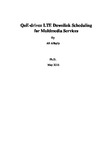QoE-driven LTE Downlink Scheduling for Multimedia Services
| dc.contributor.supervisor | Lingfen, Sun | |
| dc.contributor.author | Alfayly, Ali | |
| dc.contributor.other | School of Engineering, Computing and Mathematics | en_US |
| dc.date.accessioned | 2016-10-14T12:32:48Z | |
| dc.date.available | 2016-10-14T12:32:48Z | |
| dc.date.issued | 2016 | |
| dc.identifier | 10388370 | en_US |
| dc.identifier.uri | http://hdl.handle.net/10026.1/6527 | |
| dc.description.abstract |
The significant growth in multimedia services and traffic (e.g. VoIP, video streaming and video gaming) in current and emerging mobile networks including the latest 4G Long-Term Evolution (LTE) networks and the rising user expectation for high Quality of Experience (QoE) for these services have posed real challenges to network operators and service providers. One of the key challenges is how to bring multimedia services to the end-user over resource-constrained mobile networks with a satisfactory QoE. Cost-effective solutions are needed for network operators to improve the bandwidth usage of these mobile networks. Therefore, scheduling schemes are of extreme importance in LTE, where scheduling algorithms are responsible for the overall efficiency of resource allocation in an LTE system. The aim of the project is to develop novel QoE-driven scheduling algorithms for improving system capacity in delivering multimedia services over downlink 3GPP LTE. This is to move away from traditional QoS-driven scheduling schemes to a QoE-driven scheme which guarantee end-user satisfaction in resource allocation. The main contributions of the thesis are threefold: 1. Performance of several existing scheduling algorithms for VoIP applications was evaluated thoroughly in terms of QoE metric (i.e. MOS), instead of QoS metrics (e.g. packet loss and delay). Using QoE metrics instead of QoS ones will facilitate the development of QoE-driven scheduling schemes in order to achieve optimised end-user experiences or optimised mobile system capacity. 2. A novel QoE-driven LTE downlink scheduling scheme for VoIP application was developed to maximize the number of users per cell at an acceptable MOS score. The proposed scheme achieved significant improvement in cell capacity at an acceptable quality (75% compared to MLWDF, and 250% compared to PF and EXP-PF in all three lower speed scenarios considered). 3. A QoE-driven LTE downlink scheduling scheme for multiservice multimedia applications was developed to improve the cell capacity with satisfactory QoE for both VoIP and video streaming services. The proposed algorithm performed well in a pedestrian scenario increasing cell capacity to double for video stream with ‘Rapid Movement’ (RM) content. For ‘Medium Movement’ (MM) video content, the capacity was increased about 20% compared to MLWDF and by 40% compared to EXP-PF. In a vehicular scenario, the proposed scheme managed to enhance the cell capacity for MM video stream case. The project has led to three publications (IEEE Globecom’12 – QoEMC Workshop, IEEE CCNC’15 and IEEE MMTC E-letter/May-2015). A journal paper is in preparation. | en_US |
| dc.description.sponsorship | The Public Authority for Applied Education and Training , Kuwait | en_US |
| dc.language.iso | en | en_US |
| dc.publisher | Plymouth University | en_US |
| dc.subject | LTE | en_US |
| dc.subject | Scheduling | |
| dc.subject | QoE | |
| dc.subject | SSIM | |
| dc.subject | MOS | |
| dc.subject | VoIP | |
| dc.subject.classification | PhD | en_US |
| dc.title | QoE-driven LTE Downlink Scheduling for Multimedia Services | en_US |
| dc.type | Thesis | |
| plymouth.version | publishable | en_US |
| dc.identifier.doi | http://dx.doi.org/10.24382/1446 | |
| dc.identifier.doi | http://dx.doi.org/10.24382/1446 | |
| dc.rights.embargoperiod | No embargo | en_US |
| rioxxterms.funder | Not available | en_US |
| rioxxterms.identifier.project | Not available | en_US |
Files in this item
This item appears in the following Collection(s)
-
01 Research Theses Main Collection
Research Theses Main


